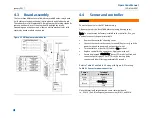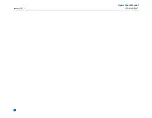
Operations Manual
FGD-MAN-0047
January 2017
7
Section 4:
Wire
4.1
Field installation
Wiring codes and regulations may vary. Wiring must comply with
applicable regulations relating to the installation of electrical
equipment in a hazardous area and is the responsibility of the installer.
If in doubt, consult a qualified official before wiring the system. See
some wiring considerations below.
If the 4–20 mA signal is not used, connect a jumper between the
4–20 mA terminal and the common terminal.
The use of shielded cable is highly recommended for signal, input,
output, and power wires to protect against interference caused by
extraneous electrical or electromagnetic noise.
In applications where the wiring cable is installed in conduit, the
conduit must not be used for wiring to other electrical equipment.
The maximum distance between sensor and controller is limited
by the resistance of the connecting wiring, which is a function of
the gauge wire being used. See
When developing a RS-485 chain of devices, the last device in the
chain requires end of line termination.
RS-485 connection 2-wire, multipoint serial line.
4.2
Seal
The use of seals is recommended to further protect the system against
any unwanted water ingression, and equipment should be installed
according to applicable local electrical codes and per the seal
manufacturers recommended guidelines. Seals are especially
recommended for installations that use high-pressure or steam
cleaning devices in proximity to the transmitter and/or sensor.
Water-proof and explosion-proof conduit seals are recommended
to prevent water accumulation within the enclosure.
Seals should be located as close to the device as possible and not
more than 18 inches (46 cm) away.
Explosion-proof installations may require an additional seal where
conduit enters a non-hazardous area. Ensure conformity with local
wiring codes.
When pouring a seal, use a fiber dam to ensure proper formation
of the seal. Seals should never be poured at temperatures below
freezing.
The jacket and shielding of the cable should be stripped back to
permit the seal to form around the individual wires. This will
prevent air, gas, and water leakage through the inside of the
shield and into the enclosure.
It is recommended that explosion-proof drains and conduit
breathers be used. In some applications, alternate changes in
temperature and barometric pressure can cause breathing which
allows moist air to enter and circulate inside the conduit. Joints in
the conduit system are seldom tight enough to prevent this
breathing. Connecting wires
Use a small screwdriver to gently press down and hold the spring
connector open.
Insert appropriate wire into open connector hole.
Release screwdriver to secure wire.
Boards are susceptible to ESD. Refer to
Appendix A: Electrostatic
sensitive device (ESD)
.
Figure 4-1 Securing wires
Summary of Contents for Net Safety MLP-A-SC1100
Page 2: ......
Page 10: ......
Page 12: ...Operations Manual January 2017 FGD MAN 0047 2 ...
Page 22: ...Operations Manual January 2017 FGD MAN 0047 12 ...
Page 26: ...Operations Manual January 2017 FGD MAN 0047 16 ...
Page 28: ...Operations Manual January 2017 FGD MAN 0047 18 ...
Page 32: ...Operations Manual January 2017 FGD MAN 0047 22 ...
Page 38: ...Operations Manual January 2017 FGD MAN 0047 28 ...
Page 45: ...Operations Manual FGD MAN 0047 January 2017 35 ...
Page 47: ...Operations Manual FGD MAN 0047 January 2017 37 ...
Page 51: ...Operations Manual FGD MAN 0047 January 2017 41 ...
Page 53: ...Notes ...
Page 54: ...Notes ...
Page 55: ......






























